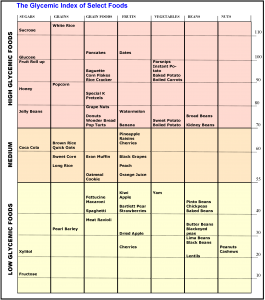You may have heard of high and low glycemic index foods and that you should eat as many low glycemic foods as you can if you want to keep your blood sugar low or if you are diabetic, but you may not have heard of the concept of Eating Below the Glycemic Index.
A typical glycemic index chart looks something like this:What you should notice about this chart, or any glycemic index chart, is that there are a number of foods that are missing. The reason why these missing foods are not on the chart is that they don’t have any effect on your blood sugar at all. But just because these foods are not on the glycemic index doesn’t mean they are not important, in fact the opposite is true.
Below the Glycemic Index Foods:
Here are the foods that are below the glycemic index. You can safely eat as much as you want of them and they will have no impact on your blood sugar:
- Onions and garlic
- Cruciferous vegetables: Broccoli, cauliflower, Brussels sprouts, chard, kale, and cabbage
- Lettuce of all kinds: red leaf, green leaf, iceberg…
- Mixed greens: spinach, arugula, endive, dandelion greens, escarole, radicchio, red mustard and various lettuces: red leaf, green leaf, romaine
- Avocados
- Meats: fish, chicken, beef, pork, wild game
- Eggs
- Mushrooms: Shitake, Maitake, Reishi and others
What is amazing about all these foods is that they are not only low on the glycemic index, but many of them are what I call Disease Busing Power Foodsbecause they pack that additional nutritional punch that makes them not only good for you, but can actually prevent (and maybe even treat) many common diseases (such as cancer, heart disease, diabetes and others).
By choosing foods from below the glycemic index, you are picking the very best nutrition you can find. You are not only keeping your blood sugar low, but you are also giving your body that extra boost it needs to navigate our stressed-out over-processed and sometimes toxic world.
Cannot Live on “Below” Alone?
You may look at the Below the Glycemic Index foods and think that you cannot live on those foods alone. Fair enough. The next best place to choose your foods from is the low glycemic index foods, the best of these include:
- Nuts: peanuts, cashews, almonds, walnuts…
- Fruits: apples, kiwi, cherries, berries (strawberries, blueberries, blackberries…)
- Beans: pinto, chickpea, butter beans, lima bean, black beans, lentils…
- Grains: while I’m not a big fan of grains, if you want to include them in your diet try to prepare them as most people make rice: boil and eat them. The whole grain with the lowest glycemic index is barley. You should also choose the whole-grain versions and not the “white” versions. If you simply must have your grains ground and processed, choose pasta as it generally is very low on the glycemic index.
Below or Low
As you can see, the best way to eat is to choose foods low or below the glycemic index. While it can be difficult at times, these foods are what your body need to thrive.
Friday, February 27, 2009
What is GLYCEMIC INDEX?
Subscribe to:
Post Comments (Atom)

No comments:
Post a Comment